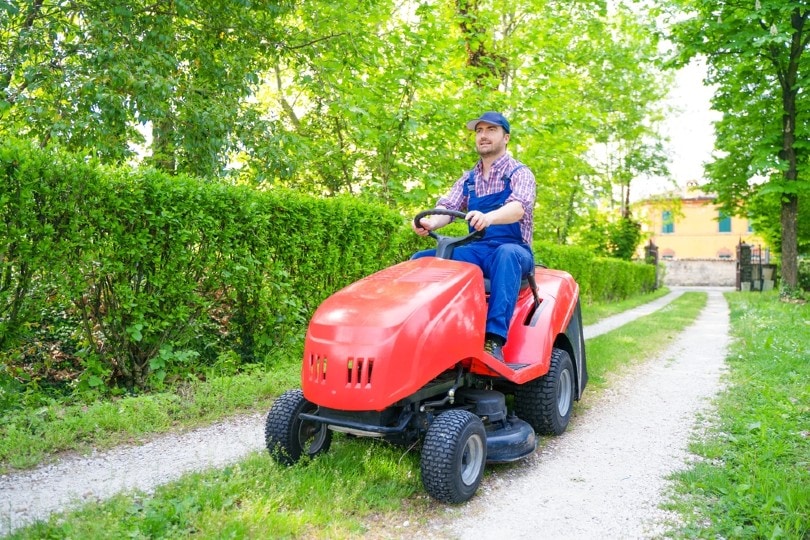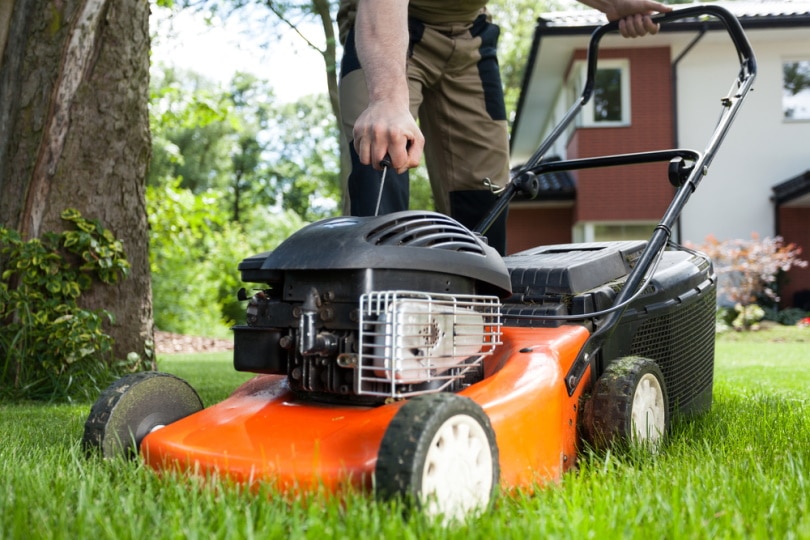How Much Horsepower Does a Lawn Mower Need? Facts & FAQ
-

- Last updated:

When searching for what type of lawn mower to purchase, the amount of horsepower is at the top of everyone’s minimum requirement. But deciding what figure to go for is the challenging bit. What do you look for to get one that will work just right?
To reduce the hustle, consider the blade and the deck. A lawn mower blade influences the amount of horsepower needed to sustain its maximum rotational power. If your blade is not more than 42 inches, your mower must produce at least 14 horsepower. Then it increases to a 16 and 24-horse-power engine for a 46 and 55-inch blade, respectively. In addition, the area you can mow will largely be influenced by the number of horsepower the lawn mower can produce.
When purchasing a lawn mower, you might want to consider the following factors concerning the horsepower you will need.
Load Capacity
Towing capacity relates to lawn tractors. You can attach big mowers, trailers, or any other peripheral item you need while cutting the grass. To calculate a mower’s load capacity, you need to add the weight of the machine and that of the driver and then make sure that figure is not more than 50% to 100% of the total weight. This will ensure your engine does not struggle while mowing.

Ground-Level
The form of terrain you are mowing, such as sloped terrain, affects the amount of horsepower the mower needs. Although it will vary when cutting downhill or uphill. Heading down the slope will require less power, and you can tow more oversized loads.
Likewise, the load capacity will decrease when heading uphill as the mower requires more engine power to pull the load. The same is the case if the ground is wet and muddy.
Braking
Bringing a mower to a stop is just as essential as starting and making it move. The braking force is even more crucial mowing down a slope where the stopping allowance increases due to the enormous momentum created. So, gauge your brakes before attaching heavy peripherals at the back.
Most mower’s load capacity is 300 to 600 pounds, but to ensure that it works effectively, the total towing weight and the operator should be less than that of your mower.
Commercial or Private Mower
The purpose of your mower will guide you on what horsepower you need. Less power will do if you use it privately on a small lawn. But if you are a professional or regularly work on a large area, investing in a lawn mower with high horsepower is a must. Most manufacturers categorize lawn mowers based on the average size they can work.
How to Get the Maximum Power Out of a Lawn Mower
Sometimes you might need more power than your mower is producing due to long mowing hours or because it has become old. You can harness extra power by tinkering with a few elements and get the mower back to its original performance levels. However, it is advisable not to try the following if your lawn mower is still under warranty.

1. Altering the Governor
The work of a governor is to regulate fuel capacity in the combustion chamber. This, in turn, predetermines the speed at which the mowing blade and the wheels will rotate. The governor doesn’t function alone but relays on spring to ensure the engine won’t consume more fuel than it requires. This is the piece to alter if you want to harvest more power. You can first reduce the length of the string and observe if there is any significant performance improvement. If this doesn’t do the trick, it is time to go big and detach the whole line.
2. Check the Air Filter
Like a car’s engine, your lawn mower will underperform if it does not get enough clean air. The machine uses air to burn fuel, thus converting the two elements into horsepower. Slow airflow or dirty air into the engine will automatically reduce your lawn mower’s efficiency. The more this goes on, the more the engine will weaken and eventually break down, forcing you into the market for a new one.
Therefore you should always ensure the air filter is clean before firing up the engine. If you notice any debris, tidy it up or if the filter is not salvageable, replace it with a brand new one.
3. The Engine Oil
The pistons in the engine need oil to move smoothly and not grind on other parts. When your lawn mower’s engine oil is low, friction increases and the blades don’t circulate normally. So just like you check your automobile’s engine oil levels every morning, you should do the same with your lawn mower. If the oil levels are low, top it back up. But it would be best to do it regularly, so you don’t have to wait for the volume to fall. And just because it’s a small machine, it does not mean you put any engine oil. For maximum horsepower, make sure you use standard engine oil like the one you put in the car.
4. Fuel
The other reason your lawn mower is not giving out all its horsepower is probably something to do with what runs it. If you are using low-quality fuel, you will get minimum horsepower returns. Changing your fuel is an excellent approach to getting those blades and wheels turning faster and without fail. If you have no idea where to start, go with super-premium fuel.
What Is More Critical: Horsepower or Torque?
Most small engine lawn mowers are rated in torque, while the ride-ons are measured in horsepower. So, to clear up the confusion, we will look at each individually and work out how to convert one to the other.

What Is Torque?
Torque is measured in terms of the revolution force produced by the engine. This is the power that makes your lawn mower blade turn and spin. If you buy a walk-behind mower, consider torque more keenly as it’s you who will be pushing it forward. And the efficiency of the blades to cut through dense grass by raw spinning power is crucial.
What Is Horsepower?
Horsepower is the measure of work a machine can accomplish in a given time. Many manufacturers will advertise riding mowers’ horsepower as opposed to torque. The mower consumes more power due to moving parts like the wheels and mowing blades. And they also have to accommodate the operator’s weight. It follows that more horsepower will translate to sufficient force and power to cut dense grass over a large area.
Frequently Asked Questions
1. Does Horsepower Matter in a Lawn Mower?
This depends on what type of lawn mower you are using. If it is a walk-behind, you should consider torque more than the amount of horsepower it can produce, and the opposite is true for ride-ons.
2. What Is the Difference Between Horsepower and CC?
Cubic centimeters refer to the size of the engine in terms of total air and fuel volume being compressed by the cylinders. And the more the CC, the greater the power it generates. But horsepower gives us the engine power.

3. What Is Considered Sufficient Torque?
Different types of lawn mowers will require varying numbers of torque to perform efficiently. A walk-behind mower calls for 4 to 5.75 foot per pound torque, but a big rider will have to produce 7 to 8.7-foot power to manage its weight and mowing. Having the right amount of torque will determine how quickly you get the job.
In Conclusion
The amount of power a lawn mower produces significantly determines how fast it can cut grass and if it can tackle dense growth. This capability is expressed in horsepower, and having a machine with the highest power output is the envy of anyone who has ever tried mowing.
Torque is also an essential measure of engine performance, although it is mainly associated with walk-behind lawn mowers.
Featured Image Credit: Roman Zaiets, Shutterstock
Contents

